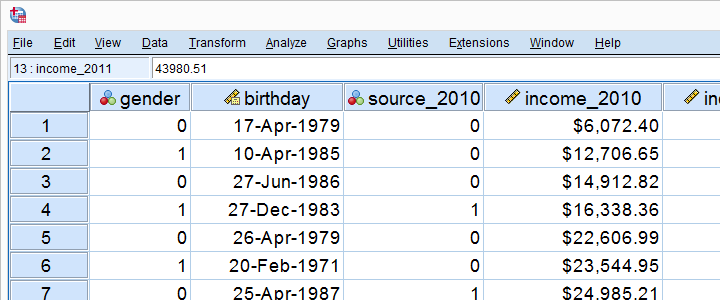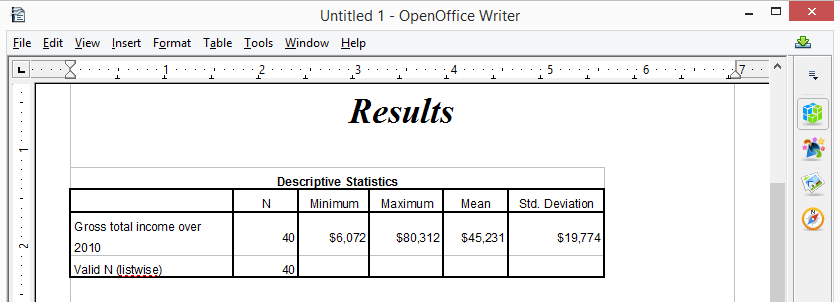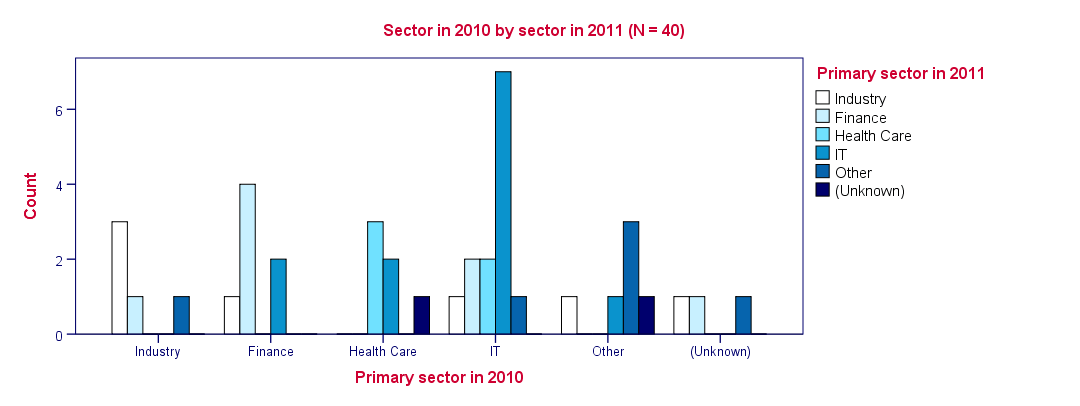what are some major benefits to using the strategic package for the social sciences

SPSS means "Due southtatistical Package for the Due southocial Due southciences" and was first launched in 1968. Since SPSS was acquired by IBM in 2009, information technology'south officially known every bit IBM SPSS Statistics only virtually users still just refer to it equally "SPSS".
SPSS - Quick Overview Primary Features
SPSS is software for editing and analyzing all sorts of information. These information may come up from basically any source: scientific research, a customer database, Google Analytics or even the server log files of a website. SPSS can open all file formats that are ordinarily used for structured information such every bit
- spreadsheets from MS Excel or OpenOffice;
- plainly text files (.txt or .csv);
- relational (SQL) databases;
- Stata and SAS.
Let's now have a quick look at what SPSS looks and feels like.
SPSS Data View
After opening data, SPSS displays them in a spreadsheet-like mode equally shown in the screenshot below from freelancers.sav.

This canvass -called data view- always displays our data values. For instance, our first record seems to incorporate a male respondent from 1979 and so on. A more detailed caption on the exact meaning of our variables and data values is institute in a 2nd sheet shown beneath.
SPSS Variable View

An SPSS data file ever has a 2d sheet called variable view. It shows the metadata associated with the data. Metadata is information almost the pregnant of variables and information values. This is generally known as the "codebook" but in SPSS it's called the lexicon.
For non SPSS users, the await and feel of SPSS' Data Editor window probably come closest to an Excel workbook containing two different but strongly related sheets.
Data Analysis
Correct, so SPSS tin can open all sorts of data and display them -and their metadata- in 2 sheets in its Data Editor window. So how to analyze your data in SPSS? Well, one selection is using SPSS' elaborate menu options.
For example, if our data comprise a variable belongings respondents' incomes over 2010, nosotros can compute the average income by navigating to as shown below.

Doing so opens a dialog box in which we select i or many variables and ane or several statistics nosotros'd similar to inspect.

SPSS Output Window
Subsequently clicking , a new window opens up: SPSS' output viewer window. It holds a nice table with all statistics on all variables we chose. The screenshot beneath shows what it looks like.

As we see, the Output Viewer window has a different layout and structure than the Data Editor window nosotros saw earlier. Creating output in SPSS does non change our data in whatsoever way; unlike Excel, SPSS uses dissimilar windows for information and research outcomes based on those data.
For non SPSS users, the look and feel of SPSS' Output Viewer window probably comes closest to a Powerpoint slide holding items such as blocks of text, tables and charts.
SPSS Reporting
SPSS Output items, typically tables and charts, are easily re-create-pasted into other programs. For instance, many SPSS users use a give-and-take processor such as MS Word, OpenOffice or GoogleDocs for reporting. Tables are unremarkably copied in rich text format, which ways they'll retain their styling such equally fonts and borders. The screenshot below illustrates the issue.

SPSS Syntax Editor Window
The output table we showed was created past running from SPSS' card. At present, SPSS has a second option for running this (or any other) command: we can open up a third window, known as the syntax editor window. Here we can type and run SPSS code known equally SPSS syntax. For instance, running descriptives income_2010. has the exact aforementioned result as running this command from SPSS' menu similar we did before.

Besides typing commands into the Syntax Editor window, virtually of them can as well exist pasted into information technology by clicking through SPSS' menu options. Like so, SPSS users unfamiliar with syntax can even so utilize it. Just why utilize syntax if SPSS has such a nice carte du jour?
The basic point is that syntax can be saved, corrected, rerun and shared between projects or users. Your syntax makes your SPSS piece of work replicable. If anybody raises any doubts regarding your outcomes, you can show exactly what you lot did and -if needed- correct and rerun it in seconds.
For non SPSS users, the look and experience of SPSS' Syntax Editor window probably come closest to Notepad: a single window basically simply containing plain text.
SPSS - Overview Main Features
At present that we have a bones idea of how SPSS works, let's take a expect at what information technology can do. Following a typical project workflow, SPSS is great for
- Opening data files, either in SPSS' own file format or many others;
- editing data such as computing sums and means over columns or rows of information. SPSS has outstanding options for more circuitous operations likewise.
- creating tables and charts containing frequency counts or summary statistics over (groups of) cases and variables.
- running inferential statistics such as ANOVA, regression and factor assay.
- saving information and output in a wide variety of file formats.
We'll now accept a closer look at each one of these features.
Opening Data Files
SPSS has its own data file format. Other file formats it easily deals with include MS Excel, apparently text files, SQL, Stata and SAS.
 Spider web analytics data -often downloaded equally Excel files- can easily be opened and further analyzed in SPSS
Spider web analytics data -often downloaded equally Excel files- can easily be opened and further analyzed in SPSS Editing Data
In existent globe research, raw information usually demand some editing before they tin can exist properly analyzed. Typical examples are creating ways or sums as new variables, restructuring data or detecting and removing unlikely observations. SPSS performs such tasks -and more circuitous ones- with amazing efficiency.
For getting things done fast, SPSS contains many numeric functions, string functions, date functions and other handy routines.
Tables and Charts
All basic tables and charts can be created hands and fast in SPSS. Typical examples are demonstrated under Information Analysis. A real weakness of SPSS is that its charts tend to be ugly and often take a clumsy layout. A great way to overcome this problem is developing and applying SPSS nautical chart templates. Doing then, all the same, requires a fair corporeality of endeavour and expertise.
 SPSS amassed bar chart with chart template applied
SPSS amassed bar chart with chart template applied Inferential Statistics
SPSS contains all bones statistical tests and multivariate analyses such equally
- t-tests;
- chi-square tests;
- ANOVA;
- correlations and other association measures;
- regression;
- nonparametric tests;
- factor analysis;
- cluster analysis.
Some analyses are bachelor merely after purchasing additional SPSS options on peak of the main program. An overview of all commands and the options to which they belong is presented in Overview All SPSS Commands.
 SPSS One Sample T-Test Output Example
SPSS One Sample T-Test Output Example Saving Data and Output
SPSS data can be saved every bit a variety of file formats, including
- MS Excel;
- plain text (.txt or .csv);
- Stata;
- SAS.
The options for output are fifty-fifty more than elaborate: charts are often copy-pasted as images in .png format. For tables, rich text format is frequently used considering it retains the tables' layout, fonts and borders.
Besides copy-pasting private output items, all output items can be exported in one go to .pdf, HTML, MS Discussion and many other file formats. A terrific strategy for writing a written report is creating an SPSS output file with nicely styled tables and chart. Then export the entire document to Word and insert explanatory text and titles betwixt the output items.
Right, I hope that gives at least a basic idea of what SPSS is and what it does. Let's now explore SPSS in some more detail, starting off with the Data Editor window. We'll nowadays many more examples in the next couple of tutorials as well.
Thanks for reading!
cunninghamamentem98.blogspot.com
Source: https://www.spss-tutorials.com/spss-what-is-it/
0 Response to "what are some major benefits to using the strategic package for the social sciences"
Post a Comment